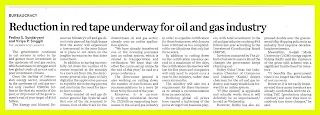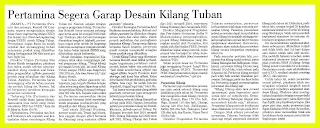Crude oil production from Banyu Urip Field, Cepu Block has reached 201,000 barrels per day or 24.36 percent of the national lifting target of 825,000 barrels per day. Currently, oil production from one of Indonesia's largest oil and gas fields is at its highest peak since its first black burst in 2015 by 85,000 barrels per day (bpd).
Banyu Urip Field Production in 2015 increased to 165,000 bpd, then increased again to 185,000 bpd earlier this year. PT ExxonMobil Cepu Limited becomes operator of oil and gas block located in Bojonegoro, East Java.
The increase of Banyu Urip oil production from 185,000 bph to 201,000 bpd was realized after the Environmental Impact Assessment (AMDAL) proposed by the US oil and gas company was approved by the Ministry of Environment and Forestry at the end of July 2017.
ExxonMobil proposed an amdal to raise oil production to 200,000 bpd by March 2017. Through the EIA permit, ExxonMobil obtained the blessing to drill from Banyu Urip to 220,000 bpd. Vice President of Public and Government Affairs ExxonMobil Indonesia Erwin Maryoto said that oil production from Banyu Urip is now above 200,000 bpd.
"CPF [processing facility center] Banyu Urip initially only 185,000 bpd and amdal may be up to 220,000 bpd. Currently, [production] has more than 200,000 bpd, "he said
In Cepu Block, ExxonMobil Cepu Ltd. Holds 20.5% share, Ampolex 24.5%. PT Pertamina EP Cepu 45%, and BUMD 10%. The oil from Banyu Urip Field will be channeled through a 95 km pipe to floating storage & offloading (FSO) Rang Rimang located in the Java Sea.
Erwin explained that in Banyu Urip there are 45 wells consisting of 30 production wells and 15 injection wells (water and gas). The additional production is proposed by ExxonMobil Cepu because of the potential increase of recoverable reserves from 450 million barrels to 725 million barrels.
According to him, Banyu Urip also produces natural gas, but is relatively small. The gas is used to fuel gas power plants for electricity needs in the oil and gas working area. He said, gas from Banyu Urip contains a lot of sulfur and carbon dioxide so that only a small part that can be utilized.
CHEAPEST CHARGE
In the meantime, the cost of oil production from Banyu Urip Field is only US $ 2.4 per barrel, the cheapest in Indonesia. Based on data from SKK Migas, the average cost of oil production in the country is around US $ 18 per barrel.
Erwin said, the low cost of oil production in Banyu Urip caused by several things. First, Banyu Urip is a new field of production. Secondly, the processing facilities in Banyu Urip have no interruption (shutdown) so that the operating costs are low. Third, the location of the oil and gas wells are closer together so it is more efficient.
Meanwhile, the cost of oil production coupled with depreciation cost in Banyu Urip is also still below US $ 10 per barrel. With current crude oil prices in the range of US $ 50 per barrel, oil production from Banyu Urip is still very profitable.
In Indonesia, ExxonMobil only operates the Cepu Block. The giant US oil and gas company Serikta has just returned East Natuna Block because it is considered not economical enough. However, ExxonMobil continues to develop other oil and gas fields in the Cepu Block, such as Kedung Keris Field, Alas Tua West, East Alas, Giyanti, and other fields.
Erwin asserted, the US-based oil and gas company will continue to look for other opportunities to invest in the country. Meanwhile, Special Unit for Upstream Oil and Gas Business Activities (SKK Migas) acknowledged that investor interest is still low on the auction of oil and gas working area.
Internal Inspector of SKK Migas Taslim Z. Yunus explained that his side together with the Ministry of Energy and Mineral Resources (ESDM) will meet one by one big investors directly to work on oil and gas blocks in Indonesia.
We will offer [oil and gas block auctions] to large companies with good finance so seriously developing oil and gas blocks. There are at least 10 investors that we will approach, "he said. In addition to the quiet of the auction of oil and gas working area, exploration activities in the last 3 years also fell quite drastically.
ExxonMobil Working Area In Cepu - Central Java
IN INDONESIA
ExxonMobil Sentuh Titik Tertinggi
Produksi minyak mentah dari Lapangan Banyu Urip, Blok Cepu telah mencapai 201.000 barel per hari atau 24,36% dari target lifting nasional sebanyak 825.000 barel per hari. Saat ini, produksi minyak dari salah satu ladang migas terbesar di Indonesia itu berada pada puncak tertingginya sejak semburan cairan hitam pertamanya pada 2015 sebanyak 85.000 barel per hari (bph).
Produksi Lapangan Banyu Urip pada 2015 meningkat menjadi 165.000 bph, kemudian meningkat lagi menjadi 185,000 bph pada awal tahun ini. PT ExxonMobil Cepu Limited menjadi operator blok migas yang berlokasi di Bojonegoro, Jawa Timur itu.
Peningkatan produksi minyak Banyu Urip dari 185.000 bph menjadi 201.000 bph itu direalisasikan setelah Analisis Mengenai Dampak Lingkungan (amdal) yang diajukan perusahaan migas asal Amerika Serikat itu disetujui oleh Kementerian Lingkungan Hidup dan Kehutanan pada akhir Juli 2017.
ExxonMobil mengajukan amdal untuk menaikkan produksi minyak ke 200.000 bph pada Maret 2017. Melalui izin amdal itu, ExxonMobil memperoleh restu untuk mengebor minyak dari Banyu Urip hingga 220.000 bph. Vice President Public and Government Affairs ExxonMobil Indonesia Erwin Maryoto mengatakan bahwa produksi minyak dari Banyu Urip saat ini sudah di atas 200.000 bph.
“CPF [pusat fasilitas pengolahan] Banyu Urip awalnya hanya 185.000 bph dan amdal boleh sampai 220.000 bph. Saat ini, [produksi] sudah lebih dari 200.000 bph,” ujarnya
Di Blok Cepu, ExxonMobil Cepu Ltd. memegang saham 20,5%, Ampolex 24,5%. PT Pertamina EP Cepu 45%, dan BUMD 10%. Minyak dari Lapangan Banyu Urip akan disalurkan melalui pipa sepanjang 95 km menuju penyimpanan minyak terapung (floating storage & offloading/FSO) Gagak Rimang yang terletak di Laut Jawa.
Erwin menjelaskan bahwa di Banyu Urip terdapat 45 sumur terdiri atas 30 sumur produksi dan 15 sumur injeksi (air dan gas). Penambahan produksi diusulkan ExxonMobil Cepu karena naiknya potensi cadangan yang bisa diangkat (recoverable reserve) dari semula 450 juta barel menjadi 725 juta barel.
Menurutnya, Banyu Urip juga menghasilkan gas bumi, tetapi relatif kecil. Gas tersebut digunakan untuk bahan bakar pembangkit listrik tenaga gas untuk kebutuhan listrik di wilayah kerja migas tersebut. Dia menuturkan, gas dari Banyu Urip mengandung banyak sulfur dan karbondioksida sehingga hanya sebagian kecil saja yang bisa dimanfaatkan.
BIAYA TERMURAH
Sememara itu, biaya produksi minyak dari Lapangan Banyu Urip hanya US$ 2,4 per barel, termurah di lndonesia. Berdasarkan data SKK Migas, rerata biaya produksi minyak di Tanah Air sekitar US$ 18 per barel.
Erwin menuturkan, rendahnya biaya produksi minyak di Banyu Urip disebabkan oleh beberapa hal. Pertama, Banyu Urip merupakan lapangan yang baru berproduksi. Kedua, fasilitas pemprosesan di Banyu Urip tidak ada gangguan (shutdown) sehingga biaya operasi rendah. Ketiga, lokasi sumur migas saling berdekatan sehingga lebih efisien.
Sementara itu, biaya produksi minyak ditambah dengan biaya depresiasi di Banyu Urip juga masih di bawah US$ 10 per barel. Dengan harga minyak mentah saat ini di kisaran US$ 50 per barel, produksi minyak dari Banyu Urip masih sangat menguntungkan.
Di Indonesia, ExxonMobil hanya mengoperasikan Blok Cepu. Perusahaan migas raksasa asal Amerika Serikta itu baru saja mengembalikan Blok East Natuna karena dianggap tidak cukup ekonomis. Namun, ExxonMobil masih terus melakukan pengembangan lapangan migas lainnya di Blok Cepu, seperti Lapangan Kedung Keris, Alas Tua West, Alas Tua East, Giyanti, dan ladang lainnya.
Erwin menegaskan, perusahaan migas asal AS itu bakal terus mencari peluang lain untuk berinvestasi di Tanah Air. Sementara itu, Satuan Kerja Khusus Pelaksana Kegiatan Usaha Hulu Minyak dan Gas Bumi (SKK Migas) mengakui bahwa minat investor masih rendah terhadap lelang wilayah kerja migas.
Pengawas lnternal SKK Migas Taslim Z. Yunus menjelaskan bahwa pihaknya Bersama dengan Kementerian Energi dan Sumber Daya Mineral (ESDM) bakal menemui satu per satu investor besar secara langsung untuk menggarap blok migas di Indonesia.
Kami akan menawarkan [lelang blok migas] kepada perusahaan besar yang memiliki finansial bagus sehingga serius mengembangkan blok migas. Setidaknya ada 10 investor yang akan kami dekati,” katanya. Selain sepinya lelang wilayah kerja migas, kegiatan eksplorasi dalam 3 tahun terakhir juga turun cukup drastis.
Bisnis Indonesia, Page-34, Monday, August 21, 2017









